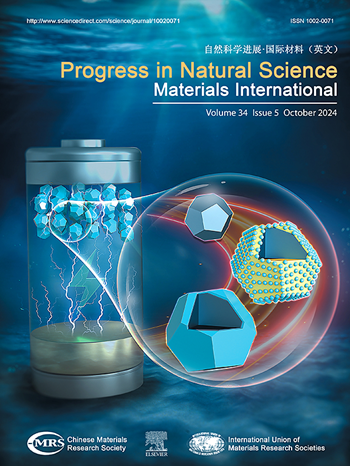Non-metal plasmonic TiN sensitized 2D CdS nanosheet arrays for efficient visible light-driven photoelectrochemical hydrogen evolution and photocatalytic degradation performance
IF 7.1
2区 材料科学
Q2 MATERIALS SCIENCE, MULTIDISCIPLINARY
Progress in Natural Science: Materials International
Pub Date : 2025-02-01
DOI:10.1016/j.pnsc.2024.12.007
引用次数: 0
Abstract
Here, a novel non-metal plasmonic TiN sensitized two-dimensional (2D) CdS nanosheet arrays (NSAs) were constructed for high-efficiency photoelectrochemical (PEC) hydrogen evolution as well as photocatalytic pollutant degradation under bias-free visible light illumination for the first time. For this patent heterogeneous nano-structures, the large surface area enables 2D CdS NSAs further to facilitate visible light absorption, as well as afford much active regions to absorb TiN nanoparticles (NPs) for boosting light energy utilization through the wide surface plasmon resonance (SPR) absorption feature of TiN. Additionally, the numerous SPR-induced TiN hot electron injection into 2D CdS efficiently augment carrier concentration. Moreover, the establishment of Schottky junction between CdS nanosheet and TiN NPs is in favour of charge migration and separation. The optimized 2D CdS/TiN NSAs achieved an obviously enhanced hydrogen production rate up to 217.2 μmol h−1, 2.02-fold higher than that of pure 2D CdS NSAs. Furthermore, the organic dye Congo red degradation efficiency on the 2D CdS/TiN NSAs reached up to 93.1 % under visible light irradiation for 120 min. The remarkably enhanced photocatalytic pollutant degradation and PEC hydrogen evolution of the 2D CdS/TiN NSAs can be attributed to the cooperative action of CdS/TiN Schottky junction and SPR effect of TiN. The demonstrations of present study offer new insights into designing non-metal-based plasmonic photocatalysts for high-efficiency PEC hydrogen generation and photocatalytic pollutant degradation from the perspectives of the visible light absorption and carrier separation and injection.
非金属等离子体TiN敏化2D CdS纳米片阵列的高效可见光驱动光电化学析氢和光催化降解性能
本文首次构建了一种新型的非金属等离子体TiN敏化二维(2D) CdS纳米片阵列(NSAs),用于无偏置可见光照明下的高效光电化学(PEC)析氢和光催化污染物降解。对于该专利的非均质纳米结构,大表面积使2D CdS nsa进一步促进可见光吸收,并提供大量活性区域来吸收TiN纳米颗粒(NPs),从而通过TiN的宽表面等离子体共振(SPR)吸收特性提高光能利用率。此外,大量的spr诱导的TiN热电子注入到2D CdS中,有效地增加了载流子浓度。此外,在CdS纳米片和TiN纳米粒子之间建立肖特基结有利于电荷迁移和分离。优化后的2D CdS/TiN nsa的产氢率达到217.2 μmol h−1,是纯2D CdS nsa的2.02倍。在可见光照射120 min下,有机染料刚果红对2D CdS/TiN nsa的降解效率可达93.1%。2D CdS/TiN NSAs光催化污染物降解和PEC析氢的显著增强可归因于CdS/TiN Schottky结和TiN的SPR效应的协同作用。本研究结果从可见光吸收和载流子分离与注入的角度为设计用于高效PEC产氢和光催化污染物降解的非金属基等离子体光催化剂提供了新的思路。
本文章由计算机程序翻译,如有差异,请以英文原文为准。
求助全文
约1分钟内获得全文
求助全文
来源期刊
CiteScore
8.60
自引率
2.10%
发文量
2812
审稿时长
49 days
期刊介绍:
Progress in Natural Science: Materials International provides scientists and engineers throughout the world with a central vehicle for the exchange and dissemination of basic theoretical studies and applied research of advanced materials. The emphasis is placed on original research, both analytical and experimental, which is of permanent interest to engineers and scientists, covering all aspects of new materials and technologies, such as, energy and environmental materials; advanced structural materials; advanced transportation materials, functional and electronic materials; nano-scale and amorphous materials; health and biological materials; materials modeling and simulation; materials characterization; and so on. The latest research achievements and innovative papers in basic theoretical studies and applied research of material science will be carefully selected and promptly reported. Thus, the aim of this Journal is to serve the global materials science and technology community with the latest research findings.
As a service to readers, an international bibliography of recent publications in advanced materials is published bimonthly.

 求助内容:
求助内容: 应助结果提醒方式:
应助结果提醒方式:


